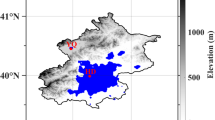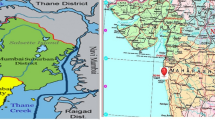Abstract
The atmospheric boundary layer (ABL) is characterized by the turbulence eddies that transport heat, momentum, gaseous constituents and particulate matter from Earth’s surface to the atmosphere and vice versa. Thus, the determination of its height has a great importance in a wide range of applications like air quality forecasting and management. This study aims at estimating the height of the ABL in a suburban environment and at investigating its temporal variation and its relationship with meteorological variables, like temperature and wind. For this purpose, radiosonde data from the suburban area of Thessaloniki, Greece, are analyzed. The data analysis reveals that ABL height is usually below 200 m in the morning hours during all seasons of the year and that is also low when near-surface temperature and wind speed are low too. Additionally, noon ABL height exhibits a strong seasonal variation, reaching higher values during summer than during winter.Very high values of ABL height, of the order of ~3,000 m, are occasionally observed in Thessaloniki during summer. Moreover, sea breeze development during summer is related to a slight reduction of the ABL height.






Similar content being viewed by others
References
Cohn SA, Angevine WM (1999) Boundary layer height and entrainment zone thickness measured by lidars and wind-profiling radars. J Appl Meteorol 39:1233–1247
Davies F, Middleton DR, Bozier KE (2007) Urban air pollution modelling and measurements of boundary layer height. Atmos Environ 41:4040–4404
Davis KJ, Gamage N, Hagelberg CR, Kiemle C, Lenschow DH, Sullivan PP (2000) An objective method for deriving atmospheric structure from airborne lidar observations. J Atmos Oceanic Tech 17:1455–1468
Garratt JR (1992) The atmospheric boundary layer. Cambridge University Press, Cambridge
Gryning S-E, Batchvarova E (2002) Marine boundary layer and turbulent fluxes over the Baltic Sea: measurements and modelling. Bound Lay Meteorol 103:29–47
Hennemuth B, Lammert A (2006) Determination of the atmospheric boundary layer height from radiosonde and lidar backscatter. Bound Lay Meteorol 120:181–200
Joffre SM, Kangas M, Heikinheimo M, Kitaigorodskii SA (2001) Variability of the stable and unstable atmospheric boundary layer height and its scales over a boreal forest. Bound Lay Meteorol 99:429–450
Johansson C, Smedman A, Högström U, Brasseur JG, Khanna S (2001) Critical test of the validity of Monin–Obukhov similarity during convective conditions. J Atmos Sci 58:1549–1566
Kambezidis HD, Peppes A, Melas D (1995) An experimental study in Athens area under sea breeze conditions. Atmos Res 36:139–156
King JC, Argentini SA, Anderson PS (2006) Contrasts between the summertime surface energy balance and boundary layer structure at Dome C and Halley stations, Antarctica. J Geophys Res 111: Art. No. D02105
Lammert A, Bösenberg J (2006) Determination of the convective boundary-layer height with laser remote sensing. Bound Lay Meteorol 119:159–170
Matsouka I (2006) The impact of the sea breeze on pollution levels in Thessaloniki. Aristotle University of Thessaloniki, Master thesis, School of Physics, Faculty of Sciences, Thessaloniki, Greece
Melas D, Ziomas IC, Zerefos CS (1994) A numerical study of dispersion in a coastal urban area. Part A: air-flow. Fresen Environ Bull 3:306–311
Melas D, Ziomas I, Klemm O, Zerefos C (1998) Flow dynamics in Greater Athens under moderate large-scale flow. Atmos Environ 32:2209–2222
Melas D, Kioutsioukis I, Lazaridis M (2005) The impact of sea breeze on air quality in Athens. In Farago I et al (eds) Advances of air pollution modelling for environmental security. Springer, Dordrecht, pp 285–296
Menut L, Flamant C, Pelon J, Flamant PH (1999) Urban boundary layer height determination from lidar measurements over the Paris area. Appl Optics 38:945–954
Norris JR (1998) Low cloud type over the ocean from surface observations. Part I: relationship to surface meteorology and the vertical distribution of temperature and moisture. J Climate 11:369–382
Papanastasiou DK, Melas D (2009) Statistical characteristics of ozone and PM10 levels in a medium sized Mediterranean city. Special issue on air pollution. Int J Environ Pollut 36:127–138
Pasquill F (1961) The estimation of the dispersion of windborne material. Meteorol Mag 90(1063):33–49
Prodanova M, Perez JL, Syrakov D, Jose RS, Ganev K, Miloshev N, Roglev S (2008) Application of mathematical models to simulate an extreme air pollution episode in the Bulgarian city of Stara Zagora. Appl Math Model 32:1607–1619
Santacesaria V, Marenco F, Balis D, Papayannis A, Zerefos C (1998) Lidar observations of the planetary boundary layer above the city of Thessaloniki, Greece. Il nuovo cimento 21(6):585–596
Schwiesow RL (1986) Lidar measurement of boundary layer variables. In: Lenschow DH (ed) Probing the atmospheric boundary layer. AMS, Boston, pp 139–162
Seibert P, Beyrich F, Gryning S-E, Joffre S, Rasmussen A, Tercier P (2000) Review and intercomparison of operational methods for the determination of the mixing height. Atmos Environ 34:1001–1027
Sempreviva AM, Gryning SE (2000) Mixing height over water and its role on the correlation between temperature and humidity fluctuations in the unstable surface layer. Bound Lay Meteorol 97:273–291
Sorensen JH (1998) Sensitivity of the DERMA long-range Gaussian dispersion model to meteorological input and diffusion parameters. Atmos Environ 32:4195–4206
Steyn DG, Baldi M, Hoff RM (1999) The detection of mixing layer depth and entrainment zone thickness from lidar backscatter profiles. J Atmos Oceanic Tech 16:953–959
Stull RB (1988) An introduction to boundary layer meteorology. Kluwer Academic Publisher, Dordrecht
Tombrou M, Dandou A, Helmis C, Akylas E, Angelopoulos G, Flocas H, Assimakopoulos V, Soulakellis N (2007) Model evaluation of the atmospheric boundary layer and mixed-layer evolution. Bound Lay Meteorol 124:61–79
Acknowledgments
The authors wish to acknowledge the Hellenic National Meteorological Service for providing the radiosonde data.
Author information
Authors and Affiliations
Corresponding author
Rights and permissions
About this article
Cite this article
Georgoulias, A.K., Papanastasiou, D.K., Melas, D. et al. Statistical analysis of boundary layer heights in a suburban environment. Meteorol Atmos Phys 104, 103–111 (2009). https://doi.org/10.1007/s00703-009-0021-z
Received:
Accepted:
Published:
Issue Date:
DOI: https://doi.org/10.1007/s00703-009-0021-z




